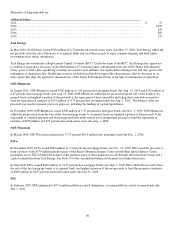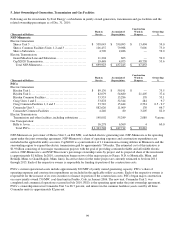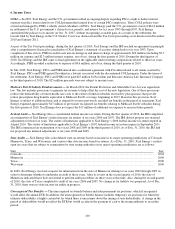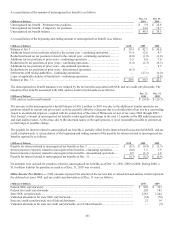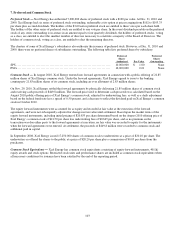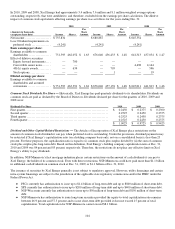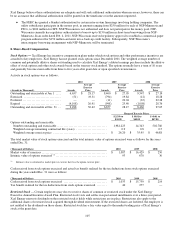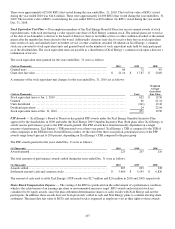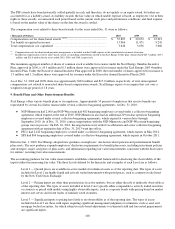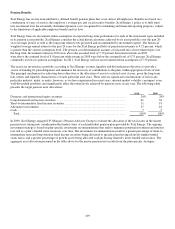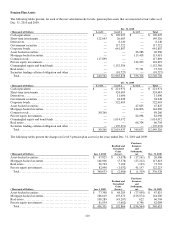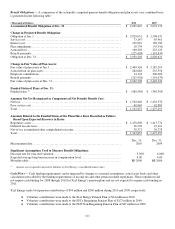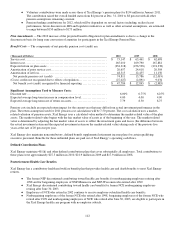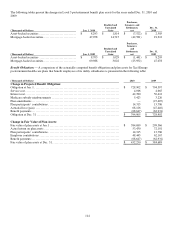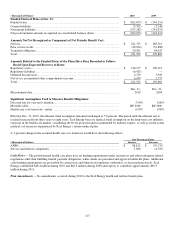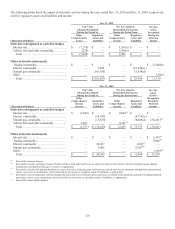Xcel Energy 2010 Annual Report Download - page 118
Download and view the complete annual report
Please find page 118 of the 2010 Xcel Energy annual report below. You can navigate through the pages in the report by either clicking on the pages listed below, or by using the keyword search tool below to find specific information within the annual report.
108
The PSP awards have been historically settled partially in cash, and therefore, do not qualify as an equity award, but rather are
accounted for as a liability award. As liability awards, the fair value on which ratable expense is based, as employees vest in their
rights to those awards, is remeasured each period based on the current stock price and performance conditions, and final expense
is based on the market value of the shares on the date the award is settled.
The compensation costs related to share-based awards for the years ended Dec. 31 were as follows:
(Thousands of Dollars) 2010 2009 2008
Compensation cost for share-based awards (a) (b) ............................... $ 35,807 $ 29,672 $ 23,912
Tax benefit recognized in income ........................................... 13,964 11,471 9,241
Total compensation cost capitalized ......................................... 3,646 3,636 3,666
(a) Compensation costs for share-based payment arrangements is included in other O&M expense in the consolidated statements of income.
(b) Included in compensation cost for share-based awards are matching contributions related to the Xcel Energy 401(k) plan, which totaled $20.7 million, $19.3
million, and $18.6 million for the years ended 2010, 2009, and 2008, respectively.
The maximum aggregate number of shares of common stock available for issuance under the Xcel Energy Omnibus Incentive
Plan, approved in 2000, is 14.5 million and 8.3 million shares were approved for issuance under the Xcel Energy 2005 Omnibus
Incentive Plan. Under the Executive Annual Incentive Plan approved in 2000, the total number of shares approved for issuance is
1.5 million, and 1.2 million shares were approved for issuance under the Executive Annual Incentive Plan in 2005.
As of Dec. 31, 2010 and 2009, there was approximately $18.6 million and $17.9 million, respectively, of total unrecognized
compensation cost related to nonvested share-based compensation awards. Xcel Energy expects to recognize that cost over a
weighted average period of 1.8 years.
9. Benefit Plans and Other Postretirement Benefits
Xcel Energy offers various benefit plans to its employees. Approximately 50 percent of employees that receive benefits are
represented by several local labor unions under several collective-bargaining agreements. At Dec. 31, 2010:
● NSP-Minnesota had 2,060 and NSP-Wisconsin had 402 bargaining employees covered under a collective-bargaining
agreement, which expired at the end of 2010. NSP-Minnesota also had an additional 219 nuclear operation bargaining
employees covered under several collective-bargaining agreements, which expired at various dates through
September 2010. As of Dec. 31, 2010, contract negotiations with the NSP-Minnesota and NSP-Wisconsin bargaining
groups were in process. On Feb. 16, 2011, the negotiations were settled via arbitration and a new collective-bargaining
agreement with an expiration date of Dec. 31, 2013 went into effect.
● PSCo had 2,142 bargaining employees covered under a collective-bargaining agreement, which expires in May 2014.
● SPS had 804 bargaining employees covered under a collective-bargaining agreement, which expires in October 2011.
Effective Jan. 1, 2009, Xcel Energy adopted new guidance on employers’ disclosures about pension and postretirement benefit
plan assets. The new guidance expands employers’ disclosure requirements for benefit plan assets, including investment policies
and strategies, major categories of plan assets, and information regarding fair value measurements consistent with the disclosures
for entities’ recurring fair value measurements.
The accounting guidance for fair value measurements establishes a hierarchal framework for disclosing the observability of the
inputs utilized in measuring fair value. The three Levels defined by the hierarchy and examples of each Level are as follows:
Level 1 — Quoted prices are available in active markets for identical assets as of the reporting date. The types of assets
included in Level 1 are highly liquid and actively traded instruments with quoted prices, such as common stocks listed
by the New York Stock Exchange.
Level 2 — Pricing inputs are other than quoted prices in active markets, but are either directly or indirectly observable as
of the reporting date. The types of assets included in Level 2 are typically either comparable to actively traded securities
or contracts or priced with models using highly observable inputs, such as corporate bonds with pricing based on market
interest rate curves and recent trades of similarly rated securities.
Level 3 — Significant inputs to pricing have little or no observability as of the reporting date. The types of assets
included in Level 3 are those with inputs requiring significant management judgment or estimation, such as asset and
mortgage backed securities, for which subjective risk-based adjustments to estimated yield and forecasted prepayments
are significant inputs.


